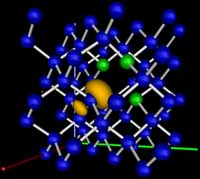|
Welcome to the Brandt group
Group leader: Prof. Dr. Martin Brandt
Degradation mechanisms in Silicon solar cells
In the mix of renewable energies, photovoltaics plays an important role. However, the prolonged illumination of solar cells with sunlight usually leads to a slow reduction of the efficiency of the energy conversion. This effect is particularly pronounced in solar cells made from hydrogenated amorphous silicon (a-Si:H). It is known that the concentration of deep defects in this material increases upon illumination, which leads to a reduction of the life time of photogenerated charge carriers and therefore to the reduction of the efficiency. What is not known is the exact microscopic structure of these defects. Detailed knowledge of this microstructure could however lead to improved deposition techniques which, in turn, might allow a suppression of the defect formation and the fabrication of more efficient thin-film solar cells.

The photogenerated defects in a-Si:H are so-called dangling bonds as shown in the figure for a similar defect in crystalline Si. These unsaturated bonds are occupied with a single electron only and can therefore be studied with electron spin resonance (ESR). To obtain relevant new spectroscopic information on these defects, several German groups are developing new ESR techniques in a concerted effort such as electrically detected magnetic resonance at high magnetic fields and ESR at THz frequencies obtained from synchrotron radiation. In this context, we build a novel microscope at the Schottky Institut which will allow the sensitive spatial mapping of dangling bond defects via electrically detected magnetic resonance.
Selected publications
-
Excitons and light-induced degradation of amorphous hydrogenated silicon
Applied Physics Letters 58 1620 (1991)
M. S. Brandt, M. Stutzmann
-
Fast Metatstable-defect creation in amorphous-silicon by femtosecond light-pulses
Physical Review Letters 67 2347 (1991)
M. Stutzmann, J. Nunnenkamp, M. S. Brandt, A. Asano
-
An alternative degradadtion method for amorphous hydrogenated silicon: The constant degradation method
Journal of Applied Physics 75 2507 (1994)
M. S. Brandt, M. Stutzmann
-
Electrically detected magnetic resonance of a-Si:H at low magnetic fields: the influence of hydrogen on the dangling bond resonance
Journal of Non-Crystalline Solids 230 343 (1998)
M. S. Brandt, M.W. Bayerl, M. Stutzmann, C.F.O. Graeff
-
Microscopic identification of the origin of generation-recombination noise in hydrogenated amorphous silicon with noise-detected magnetic resonance
Physical Review Letters 84 5188 (2000)
S.T.B. Goennenwein, M.W. Bayerl, M. S. Brandt, M. Stutzmann
Collaborations
Funding
BMBF Verbundprojekt EPR-Solar
Funding Number 03SF0328B
|
|
|



 The photogenerated defects in a-Si:H are so-called dangling bonds as shown in the figure for a similar defect in crystalline Si. These unsaturated bonds are occupied with a single electron only and can therefore be studied with electron spin resonance (ESR). To obtain relevant new spectroscopic information on these defects, several German groups are developing new ESR techniques in a concerted effort such as electrically detected magnetic resonance at high magnetic fields and ESR at THz frequencies obtained from synchrotron radiation. In this context, we build a novel microscope at the Schottky Institut which will allow the sensitive spatial mapping of dangling bond defects via electrically detected magnetic resonance.
The photogenerated defects in a-Si:H are so-called dangling bonds as shown in the figure for a similar defect in crystalline Si. These unsaturated bonds are occupied with a single electron only and can therefore be studied with electron spin resonance (ESR). To obtain relevant new spectroscopic information on these defects, several German groups are developing new ESR techniques in a concerted effort such as electrically detected magnetic resonance at high magnetic fields and ESR at THz frequencies obtained from synchrotron radiation. In this context, we build a novel microscope at the Schottky Institut which will allow the sensitive spatial mapping of dangling bond defects via electrically detected magnetic resonance.